May 2014
Local traditions - the Good Friday service
29/05/14 08:32
Springhill is in parish of Newchurch St Nicholas which lies about half a mile away and dates from 1511. It nestles at the foot of a hill called Seat Naze.
In the 1970s St Nicholas and the nearby Methodist and Baptist churches (including Sion Cloughfold in Springhill) met on Good Friday for a united service followed by carrying a cross up Seat Naze where it was erected. This was then followed by a walk, usually over the moors to Burnley.
The cross remained on the top of the hill for 40 days until Ascension and was clearly seen over much of Rossendale. The view from Edgeside, with the sun setting behind the cross, was particularly beautiful.
Then in the early 1980s the climb up the hill stopped. Rumour had it that the new vicar of Newchurch chose to change his milk supplier and the farmer retaliated by banning access over his land - the right of way over Seat Naze does not go to the summit. Whatever the truth of this the climb was replaced by a united service in the village green where the cross is erected until Ascension Day as before. This has continued for 30 years now and has been respected with no acts of vandalism, but it’s not the same as having the cross on the hill.
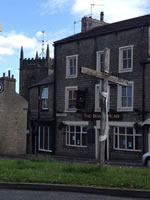
(Newchurch St Nicholas and the Boar’s Head in the background)
A little further along to the west of Seat Naze is Saunder Height. About 4 years ago the residents of a farm there placed a cross in their field which remains there all year. This is seen over Springhill, Newchurch Road and Rawtenstall and again is lovely with the sun behind it.
Dawn and sunset respectively, pictures courtesy of Suzie Elkington.
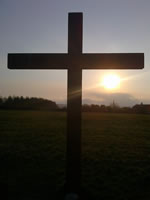
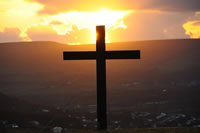
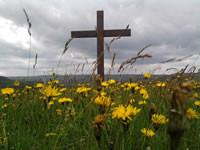
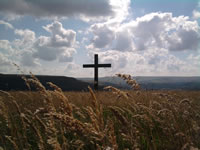
In the 1970s St Nicholas and the nearby Methodist and Baptist churches (including Sion Cloughfold in Springhill) met on Good Friday for a united service followed by carrying a cross up Seat Naze where it was erected. This was then followed by a walk, usually over the moors to Burnley.
The cross remained on the top of the hill for 40 days until Ascension and was clearly seen over much of Rossendale. The view from Edgeside, with the sun setting behind the cross, was particularly beautiful.
Then in the early 1980s the climb up the hill stopped. Rumour had it that the new vicar of Newchurch chose to change his milk supplier and the farmer retaliated by banning access over his land - the right of way over Seat Naze does not go to the summit. Whatever the truth of this the climb was replaced by a united service in the village green where the cross is erected until Ascension Day as before. This has continued for 30 years now and has been respected with no acts of vandalism, but it’s not the same as having the cross on the hill.

(Newchurch St Nicholas and the Boar’s Head in the background)
A little further along to the west of Seat Naze is Saunder Height. About 4 years ago the residents of a farm there placed a cross in their field which remains there all year. This is seen over Springhill, Newchurch Road and Rawtenstall and again is lovely with the sun behind it.
Dawn and sunset respectively, pictures courtesy of Suzie Elkington.




don't go that way!
28/05/14 23:17
Found a tracking mark made by a group of Scouts or similar on the path up to Balladen Brook yesterday.
I hope nobody tries to follow it as it leads directly into a hawthorn hedge...
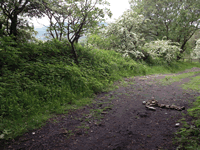
I hope nobody tries to follow it as it leads directly into a hawthorn hedge...

more questions than answers: John Heaton alias Bridge
23/05/14 21:00
Just transcribed the will of William Heaton, d 1654, who left a number of small monetary bequests to local people without stating where they lived, and a number of bequests to people of the same surname without stating the relationship. Frustrating, but pretty standard stuff.
This bit is fascinating though...
‘Item I give and bequeath unto John Heaton alias Bridge twenty shillings a year for the time of four years after my death and forty shillings more to bind him prentice to learn some trade if any man will undertake to do it for him’.
This is the only bequest of its type and begs a number of questions:
was John Heaton alias Bridge an illegitimate child of William? Or an illegitimate child of one of William’s sisters/other relative by one of the Bridge family?
William had plenty of land and could have set John up if he had wished. Something must have triggered a desire for John to earn his way - wonder what happened?
Why wait until his death to enable John to be apprenticed? If it was in John’s best interests to learn a trade then why not get on with it?
Why the doubt that a master could be found?
Was a master ever found, and if so who and in what trade?
Study of the court rolls shows that the Bridge family had a bit of a dodgy reputation a century earlier (‘J is for...’ below). Had this continued?
What we do know:
John Heaton fil Wm Heaton of Deadwenclough bap Newchurch St Nicholas 28 Sept 1640.
Wilimi Heaton fil Johnis Heaton of Deadwenclough bap Newchurch St Nicholas ? Oct 1616
Jo. Bridge fil Tho Bridge of Deadwenclough gap Newchurch St Nicholas 10 Oct 1635
John Bridge m Ann Haworth 14 Nov 1668 Newchurch St Nicholas
John Heaton of Newchurch m Margaret Aspen of Burnley, widow of Richard Aspden deceased by Banns read on 26 May 1656, 1 Jun 1656 and 8 Jun 1656 at Newchurch St Nicholas
William Heaton bur 21 Dec 1654 Newchurch St Nicholas
This bit is fascinating though...
‘Item I give and bequeath unto John Heaton alias Bridge twenty shillings a year for the time of four years after my death and forty shillings more to bind him prentice to learn some trade if any man will undertake to do it for him’.
This is the only bequest of its type and begs a number of questions:
was John Heaton alias Bridge an illegitimate child of William? Or an illegitimate child of one of William’s sisters/other relative by one of the Bridge family?
William had plenty of land and could have set John up if he had wished. Something must have triggered a desire for John to earn his way - wonder what happened?
Why wait until his death to enable John to be apprenticed? If it was in John’s best interests to learn a trade then why not get on with it?
Why the doubt that a master could be found?
Was a master ever found, and if so who and in what trade?
Study of the court rolls shows that the Bridge family had a bit of a dodgy reputation a century earlier (‘J is for...’ below). Had this continued?
What we do know:
John Heaton fil Wm Heaton of Deadwenclough bap Newchurch St Nicholas 28 Sept 1640.
Wilimi Heaton fil Johnis Heaton of Deadwenclough bap Newchurch St Nicholas ? Oct 1616
Jo. Bridge fil Tho Bridge of Deadwenclough gap Newchurch St Nicholas 10 Oct 1635
John Bridge m Ann Haworth 14 Nov 1668 Newchurch St Nicholas
John Heaton of Newchurch m Margaret Aspen of Burnley, widow of Richard Aspden deceased by Banns read on 26 May 1656, 1 Jun 1656 and 8 Jun 1656 at Newchurch St Nicholas
William Heaton bur 21 Dec 1654 Newchurch St Nicholas
Sounds of your place
15/05/14 20:59
It started with a chance remark from my mother many years ago.
There were roadworks on Newchurch Road just south of Springhill and the road was closed except for access. This turned a busy thoroughfare into a quiet country lane and Mum commented that it was like the old days as the road was so quiet.
Many years later and I was listening to the owl one night and wondering just which sounds encapsulated a place and how to record and document them. What are the everyday noises which you hear day to day? How many of these are commonplace and how many specific to a place? Is there something about the combination of sounds in your place which tell a story?
So in no particular order, the sounds of Springhill include:
the dawn chorus
the night-time wildlife - owls, foxes and a cat which has been shut out overnight
the hum of traffic in the distance (there is little traffic in Springhll itself)
occasional aeroplanes overhead
the church bells from Newchurch St Nicholas
the chime of Rawtenstall St Mary, on a clear night
the metallic noise made by a miss-hit golf ball hitting the wall of the driving range
the rugby club on the sports field 20 yards away on the other side of the field
then there are the hidden sounds like the bats - noise enough if we could but hear it.
But noises change over time. In Springhill the most obvious example is the sound of cattle entering the abattoir at Johnny Barn about 50 yards away, though we never heard the sound of the killing. This stopped with the closure of the abattoir in the 1980s and that sound is no longer part of the landscape. Similarly the conversion of Springhill farm into ‘des reses’ has removed the sound of the geese, to be replaced by next door’s hens...
So I sat on the lane this evening and just let the recorder run for a few minutes. The tracks are nothing special: a selection of birds, the hum of traffic on the main road, an ambulance in town a mile away, an aeroplane overhead, someone hanging out washing. Nothing distinctive, nothing out of the ordinary, nothing special. But they do represent part of the history of this place at this time. In 30 years it will be different.
sounds Springhill 15 May 2014 1
sounds Springhill 15 May 2014 2
There were roadworks on Newchurch Road just south of Springhill and the road was closed except for access. This turned a busy thoroughfare into a quiet country lane and Mum commented that it was like the old days as the road was so quiet.
Many years later and I was listening to the owl one night and wondering just which sounds encapsulated a place and how to record and document them. What are the everyday noises which you hear day to day? How many of these are commonplace and how many specific to a place? Is there something about the combination of sounds in your place which tell a story?
So in no particular order, the sounds of Springhill include:
the dawn chorus
the night-time wildlife - owls, foxes and a cat which has been shut out overnight
the hum of traffic in the distance (there is little traffic in Springhll itself)
occasional aeroplanes overhead
the church bells from Newchurch St Nicholas
the chime of Rawtenstall St Mary, on a clear night
the metallic noise made by a miss-hit golf ball hitting the wall of the driving range
the rugby club on the sports field 20 yards away on the other side of the field
then there are the hidden sounds like the bats - noise enough if we could but hear it.
But noises change over time. In Springhill the most obvious example is the sound of cattle entering the abattoir at Johnny Barn about 50 yards away, though we never heard the sound of the killing. This stopped with the closure of the abattoir in the 1980s and that sound is no longer part of the landscape. Similarly the conversion of Springhill farm into ‘des reses’ has removed the sound of the geese, to be replaced by next door’s hens...
So I sat on the lane this evening and just let the recorder run for a few minutes. The tracks are nothing special: a selection of birds, the hum of traffic on the main road, an ambulance in town a mile away, an aeroplane overhead, someone hanging out washing. Nothing distinctive, nothing out of the ordinary, nothing special. But they do represent part of the history of this place at this time. In 30 years it will be different.
sounds Springhill 15 May 2014 1
sounds Springhill 15 May 2014 2
Local traditions - the Nutters
10/05/14 21:22
Janet Few recently blogged (April 16th) on the importance of remembering and describing local customs and their importance to your one-place study. I don’t think there are any which are specific to the Springhill area or even Higher Cloughfold but there are a few of interest which are only slightly further afield.
Of these perhaps the best known is the Britannia Coconutters, a morris dance troupe which date over 150 years. Their Easter dance starts at the Travellers’ Rest in Whitworth at 9 am on Easter Saturday and dances through the streets of Bacup to the far boundary at Stacksteads, traditionally calling at every licensed premises on the way. Hic. The route is shown in the map below by the local historian the late John B Taylor whose work has contributed greatly to this study in many ways. Sadly, the route doesn’t pass through Higher Cloughfold.
They dance in blackup and have done so throughout their history. This may be a reflection of their supposed mining origins or so that the spirits don’t recognise the dancers. From time to time some try and attach less pleasant motives to the use of blackup; an interesting discussion between the secretary of the Nutters and a representative from the Society of Black Lawyers on the Radio 4 PM programme recently led to the latter declaring that they had no problem with it. Another threat comes from the lack of public sector funding which has led to the authorities threatening to withdraw support to marshall the route. This is an ongoing issue and the future of the Easter Saturday dance is somewhat precarious.
They perform five garland dances performed in square set and two nut dances performed in line. An example of their dancing is seen in this video. I was fortunate enough to have been given copies of the music used for marching and one of their dances; these are also below. Clicking on the image will lead to larger copies.
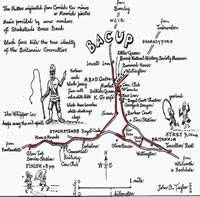
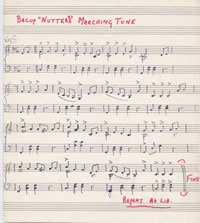
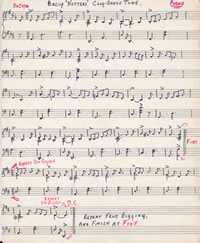
This extract of the history is from the Nutter’s own site:
“The picture is by no means clear and tales have been related by word of mouth, however the dances are supposed to have originated with moorish pirates (hence the costume). Some of these sailors are said to have settled in Cornwall and become employed in local mining. As mines and quarries opened in Lancashire in the 18th and 19th century a few Cornishmen came North bringing with them mining expertise. It is with these people that the dances were reputedly bought to this area, in particular two Cornishmen who came to work in Whitworth (this was related by a former team member many years ago). The Dances spread throughout Rossendale and around the turn of the Century there were at least four troupes. One of these was the Tunstead Mill Troupe who celebrated their half century in 1907. It is from this troupe that Britannia is descended.”
Of these perhaps the best known is the Britannia Coconutters, a morris dance troupe which date over 150 years. Their Easter dance starts at the Travellers’ Rest in Whitworth at 9 am on Easter Saturday and dances through the streets of Bacup to the far boundary at Stacksteads, traditionally calling at every licensed premises on the way. Hic. The route is shown in the map below by the local historian the late John B Taylor whose work has contributed greatly to this study in many ways. Sadly, the route doesn’t pass through Higher Cloughfold.
They dance in blackup and have done so throughout their history. This may be a reflection of their supposed mining origins or so that the spirits don’t recognise the dancers. From time to time some try and attach less pleasant motives to the use of blackup; an interesting discussion between the secretary of the Nutters and a representative from the Society of Black Lawyers on the Radio 4 PM programme recently led to the latter declaring that they had no problem with it. Another threat comes from the lack of public sector funding which has led to the authorities threatening to withdraw support to marshall the route. This is an ongoing issue and the future of the Easter Saturday dance is somewhat precarious.
They perform five garland dances performed in square set and two nut dances performed in line. An example of their dancing is seen in this video. I was fortunate enough to have been given copies of the music used for marching and one of their dances; these are also below. Clicking on the image will lead to larger copies.



This extract of the history is from the Nutter’s own site:
“The picture is by no means clear and tales have been related by word of mouth, however the dances are supposed to have originated with moorish pirates (hence the costume). Some of these sailors are said to have settled in Cornwall and become employed in local mining. As mines and quarries opened in Lancashire in the 18th and 19th century a few Cornishmen came North bringing with them mining expertise. It is with these people that the dances were reputedly bought to this area, in particular two Cornishmen who came to work in Whitworth (this was related by a former team member many years ago). The Dances spread throughout Rossendale and around the turn of the Century there were at least four troupes. One of these was the Tunstead Mill Troupe who celebrated their half century in 1907. It is from this troupe that Britannia is descended.”
traditional agriculture
05/05/14 22:06
Sadly not in Springhill, but it was interesting to see a bit of traditional agriculture today in a field in Grane about three miles away.
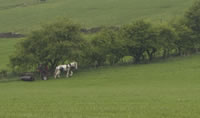
Despite its reputation for being old fashioned, Springhill Farm did have tractors when I remember it in the late 1960s. Of course this is how the fields would have been mown in Patrick’s day (1855-1896) though I suspect not by Patrick himself.

Despite its reputation for being old fashioned, Springhill Farm did have tractors when I remember it in the late 1960s. Of course this is how the fields would have been mown in Patrick’s day (1855-1896) though I suspect not by Patrick himself.
April A-Z blog challenge- lessons learned
01/05/14 21:31
With the end of April the A-Z blog challenge concludes and it seems appropriate to reflect on the month’s activities. So what have I learned?
Firstly blogging. This blog was started pretty much for the challenge but I can see its value as a place for recording interesting snippets, maybe a research log, possibly other challenges. I noted at the beginning that some of the blogs out there seem somewhat erudite and that remains but we start small and learn. That is the plan, anyway. So I need to do some research into other one-place studies blogs.
Second, one place studies. It was interesting over the month to notice how frequently I was typing the same things over again. Some of these links and concoctions were known about before, others only became apparent as the month progressed. Some are of importance and are worth exploring, others of idle curiosity only but might still be fun to consider further.
So what were these themes?
the ubiquitous Ashworths. I knew John Ashworth was important as builder of Springhill House but the name keeps cropping up. Were they related?
the links with a range of non-conformist denominations (three mentioned in the challenge, Wesley preached a mile away as well) and why such a remote, poorly inhabited place was important in the history of so many nonconformist denominations
the poor highways and failure to maintain them.
the inevitable ‘two bits of moor’ which seem to crop up in historical and modern administrative areas meaning that the different parts of the area have little contact or relation with each other. They are different bits of moor for different administrative areas as well.
how geology and geography influences events in the place: who, what, how and why? I wish I’d listened in goeg at school now...
Thanks to all who visited and commented.
Firstly blogging. This blog was started pretty much for the challenge but I can see its value as a place for recording interesting snippets, maybe a research log, possibly other challenges. I noted at the beginning that some of the blogs out there seem somewhat erudite and that remains but we start small and learn. That is the plan, anyway. So I need to do some research into other one-place studies blogs.
Second, one place studies. It was interesting over the month to notice how frequently I was typing the same things over again. Some of these links and concoctions were known about before, others only became apparent as the month progressed. Some are of importance and are worth exploring, others of idle curiosity only but might still be fun to consider further.
So what were these themes?
the ubiquitous Ashworths. I knew John Ashworth was important as builder of Springhill House but the name keeps cropping up. Were they related?
the links with a range of non-conformist denominations (three mentioned in the challenge, Wesley preached a mile away as well) and why such a remote, poorly inhabited place was important in the history of so many nonconformist denominations
the poor highways and failure to maintain them.
the inevitable ‘two bits of moor’ which seem to crop up in historical and modern administrative areas meaning that the different parts of the area have little contact or relation with each other. They are different bits of moor for different administrative areas as well.
how geology and geography influences events in the place: who, what, how and why? I wish I’d listened in goeg at school now...
Thanks to all who visited and commented.




